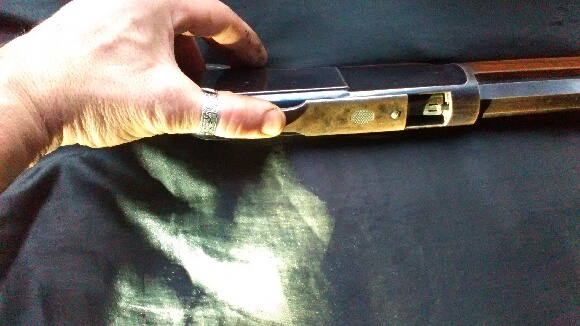May 28, 2013
 Offline
OfflineI posted below about my 76 in the 2600 serial range in 45-75 cal. I researching 76’s as I do when I get a new rifle, I find a 76 in the 3700 range that is an open top. In looking further I find a 76 in the 3800 range with a thumb print dust cover like mine. I then find advertised an open top in the 5800 serial range.My 2600 range gun has a thumb print dust cover is cut for a set trigger with no set trigger parte what so ever present. the pin hole behind the trigger pin is filled with two ends of a set trigger pin and the hole for the catch hook farther back in the tang has nothing filling that hole and no evidence of anyhting ever being there.
I have to assume the order was changed before shipping. I’m really confused about the published data on dust cover/no dust cover serial range.Anybody out there have any info to share? Thanks
March 20, 2010
 Offline
OfflineYours may have a history like mine. It started out as a 45-75 with set trigger, then it was changed at the factory to a 45-60 with plain trigger. The letter on mine reads:
SN 2545
Rifle
Octagonal Barrel (no mention of caliber as early production were all 45-75)
Set Trigger
Received in the warehouse on May 2, 1878
Changed to 45/60, 30 inch, octagon barrel and plain trigger
Shipped from warehouse on June 5, 1880
With 5 other arms to order number 20156
If you have a copy of the Summer 2013 Winchester Collector magazine there is an article by Rob Kassab discussing 1873 open top rifles that may be of interest.

1892takedown @sbcglobal.net ......NRA Endowment Life Member.....WACA Member
"God is great.....beer is good.....and people are crazy"... Billy Currington
December 1, 2012
 Offline
OfflineIn the manufacturing process Winchester assemblers removed the needed parts from a parts bin. The process was not precise as the bins were refilled before the bin was emptied. Occasionally, an older part was retrieved and installed after a modification was called for, which would explain transition periods for model modifications.
The photo above shows the factory modification with the lower tang having the slot for the set trigger and also having a hole for the stud of the trigger bar safety catch with the stud protruding through it. The trigger bar was not used on Model 1976’s factory equipped with set triggers. It would be physically impossible to install both these features. You haven’t posted a photo of you 1876 nor mentioned the safety bar. My guess would be that if you have a safety bar installed your rifle was modified by the factory. If you don’t have a safety bar, someone just removed the set trigger, which is easily damaged, and replaced it with a standard trigger.
Another place to look might be the mainspring. Is it a standard one or a skewed one for the set trigger?
![]()
"This is the West, sir. When the legend becomes fact, print the legend."
May 28, 2013
 Offline
OfflineWINCACHER: Yes it seems to be just like yours, factory safety bar is in place.You seem to need some voodoo to post pictures on this sight otherwise I would be glad to do it. I could email pictures to someone who would post them for me.
Just to add another tidbit of interest, I was visiting my buddys gun shop today to use his hawkeye bore scope to check out my barrel. when I bought the gun I took it home and ran a brush with some hoppes down the pipe and followed it with a couple dry patches.I was pleased to see a clean shiney bore.
Out of curiosity I thought a bore scoping would be fun. To my surprise I found a few scattered spots of surface rust much like moisture or poor storage would cause. The amazing part was the entire majority or the bore was absolutley new. the steel was still in the white with all the cutter or lapping marks visible.There was no evidence of jacket material or lead smearing any where. I think it was just carried around a little and if shot at all it was cleaned by someone who loved the gun and spent a small fortune on it in 1877.I have never seen a black powder gun with a bore that new except for the unissued Spencer I just sold.
This must be one of those rare guns that was lightly used if at all but well taken care of. When I got it the firing pin was locked forward. When I took the side plates off to inspect the cause, I noticed the firing pin retractor was missing. It seems someone continually snapped the hammer until peening over the stop shoulder in the bolt until it seezed the pin. I corrected that and put in a new retractor and all is well.
I apologize for being so verbose, but an old gun in nice shape excites me.
January 28, 2016
 Offline
OfflineWith regard to the dust cover question, I have a 76 in the 1000 range. Cody letter states “lid”. The gun would have been an open top but had a thumb print dust cover added at the factory. Additionally, the bolt needed to be modified in order that it had a provision to open the dust cover when the lever is worked. The bolt is stamped with the serial number of the gun.


 Log In
Log In






